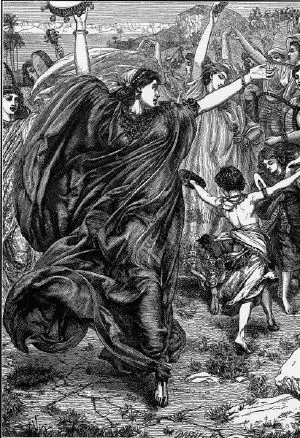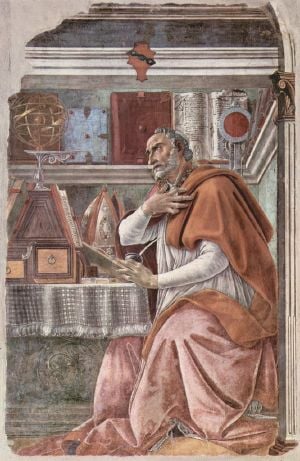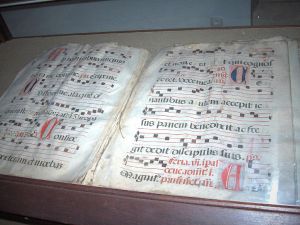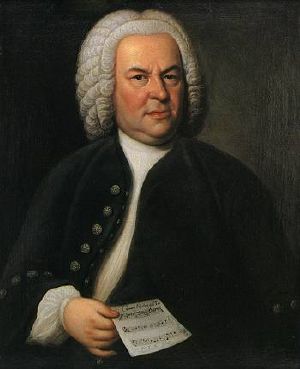Liturgical music
Liturgical music is a form of music originating as a part of religious ceremony. It includes a number of traditions, both ancient and modern. Liturgical music is best known as a part of Catholic Mass, the Anglican Holy Communion service, the Lutheran mass, the Orthodox liturgy and other Christian services including the Divine Office. Such ceremonial music in the Judeo-Christian tradition can be traced back to both Temple and synagogue worship of the Hebrews.
The qualities that create the distinctive character of liturgical music are rooted in the music's conception and composition according to the norms and needs of the various historic liturgies of particular denominations. Although it is most common to attribute the term to Western and Judeo-Christian traditions, music accompanying religious rituals can be traced back to ancient cultures such as Chinese and Indian as well.
For composers of the Baroque period, the composition of music was not primarily an exercise in compositional interplay, but rather possessed deep spiritual and religious underpinnings. Johann Sebastian Bach stated, "The sole and end aim of figured-bass should be nothing else than God's glory and the recreation of the mind. Where this object is not kept in view, there can be no true music, but only infernal scraping and bawling." Bach was influenced greatly by Martin Luther's assertion that music was, "a gift from God, not a human gift" and "a sermon in sound."
Contemporary liturgical music includes a wide variety of forms and styles, from Gregorian chant to popular Christian hymns and African drumming.
Jewish tradition
Sacred singing in Hebrew tradition dates back to songs of Miriam and Moses, reportedly sung when the Israelites crossed the Red Sea. King David is traditionally believed to have written most of the biblical psalms. However, scholars believe that many of them were composed substantially later by priests and designed to be sung in the Temple in Jerusalem as part of the formal liturgy.
The psalms covered a wide variety of genres, from prayers of supplication to mourning, triumphal marches, and enthronement hymns. Many were songs of praise, as typified by Psalm 98: "Make a joyful noise unto the Lord, all the earth: make a loud noise, and rejoice, and sing praise."
Biblical and Talmudic sources mention the following instruments that were used in the ancient Temple:
- the Nevel, a 12-stringed harp;
- the Kinnor, a lyre with ten strings;
- the Shofar, a hollowed-out ram's horn;
- the chatzutzera, or trumpet, made of silver;
- the tof or small drum;
- the metziltayim, or cymbal;
- the paamon or bell;
- the halil or big flute.
According to the Mishna, the regular Temple orchestra consisted of 12 instruments, and the choir of 12 male singers. The earliest synagogal music was based on the system reportedly used in the Temple.
After the destruction of the Temple and the subsequent diaspora of the Jewish people, a consensus developed that all music and singing would be banned. This was codified as a rule by the early Jewish rabbinic authorities. However, the ban on singing and music soon became understood as applying only outside of religious services. Within the synagogue, the custom of singing soon re-emerged.
Jewish liturgical music began to crystallize into definite form with the piyyutim (liturgical poems), many of which show an interplay with Islamic influences resulting from the Jewish diaspora in Muslim lands. A similar influence from the Christian musical tradition was felt later in Europe. The cantor sang the melodies selected by the writer or by himself, thus introducing fixed melodies into synagogal music. Cantors also continued to recite traditional prayers, which were chanted more than sung. In moments of inspiration a cantor would sometimes give utterance to a phrase of unusual beauty, which would occasionally find its way into the congregational tradition and be passed on to succeeding generations.
Today, most of the Jewish liturgy is sung or chanted with traditional melody or trope. Depending upon the size and platform, many synagogues designate or employ a professional or lay hazzan (cantor) for the purpose of leading the congregation in prayer.
Christian tradition of liturgical music
With the decline of Rome and the ascendancy of Christianity in Europe during the third and fourth centuries, the seeds that would blossom into Western music were planted deeply into the fertile soil of religious faith and practice. Arnold Toynbee's assessment that the Christian church as "the chrysalis out of which our Western society emerged," attests to the role that Christian thought played in the development of Western musical theory, aesthetics and axiology.
The early church was a small, vulnerable group with one of its missions being to convert pagan Europe. It thus endeavored to resist any influence by the surrounding pagan cultures. Early Christians felt this to be crucial to their mission and deemed it necessary to subordinate all earthy things, including music, to the ultimate goal of protecting the eternal condition of one’s soul.
Greek philosophy, which came to the early Christian church via Rome, held that music was a medium that had connections to the forces of nature and possessed the power to affect human thought and conduct. This attitude was assimilated into early church culture and reiterated in the writings of several Christian philosophers, most notably Boethius (ca. 480-524 C.E.) and St. Augustine (354-430 C.E.). Boethius' treatise De Institutione musica stood as an authoritative source of understanding for composers of Medieval times.
The evolution of music and its integration into liturgical practice throughout the Middle Ages gave rise to new attitudes about music and its purpose and function; most notably the idea that music was to be the "servant" of religion. For the Church elders of the Middle Ages, music was deemed good only when it "opens the mind to Christian teachings and disposes the soul to holy thoughts." The Church was concerned with the potentially corrupting elements of music and as a result certain factions within Church hierarchy that felt art in general, and music in particular, was inimical to religion. Instrumental music especially was often denigrated as related to the body rather than the spirit, and associated with the "old" Jewish covenant with God as opposed to the "new" Christian covenant.
Yet the aesthetic beauty of music could not be denied. The medieval Christian concept that spiritual fulfillment and redemption was somehow hindered or obstructed by pleasurable things such as music troubled even the most enlightened practitioners of the faith. St. Augustine's observed on this dilemma:
"When I call to mind the tears I shed at the songs of my church... I then acknowledge the great utility of this custom. Thus vacillate I between dangerous pleasure and tried soundness; being inclined rather to approve of the use of singing in the church, that so by delights the ear the weaker minds may be stimulated to a devotional frame. Yet when it happens to me to be more moved by the singing than by what is sung, I confess myself to have sinned criminally, and then would rather not have heard the singing."
As music historian Daniel J. Grout points out, there is music in every Age that is not suitable for religious or devotional purposes. The Christian church, like the ancient cultures of Ages past, made a distinction between sacred and secular art which it thought necessary to the process of inculcating its converts with an ascetic principle that could endure and survive any corrupting influences.
Stress of vocal forms
The interest taken by the Catholic Church in music is shown not only by its practitioners, but also by numerous enactments and regulations calculated to foster music worthy of the divine service. Since it was generally believed that instruments could not illicit the spirit of divinity as well as vocal music, instrumental music was for the most part excluded in the liturgical tradition in the early and Medieval church. This preference for vocal music was a significant factor as to why Gregorian Chant and plainsong became the predominant mediums for liturgical music for hundreds of years.
The Mass, as a form of sacred musical composition, is a choral composition that sets the fixed portions of the Eucharistic liturgy (principally that of the Roman Catholic Church, the Churches of the Anglican Communion, and also the Lutheran Church) to music. The earliest musical settings of the Mass are Gregorian chant.
The development of chants into music with multiple voices and the early polyphonic style of the thirteenth-century culminated in the compositions of the Notre-Dame school composers Léonin and Pérotin. Not until the early fourteenth century did composers began writing polyphonic versions of the sections of the Mass. The liturgical music of the early-Renaissance composers Dufay, Gabrieli, Obrecht, Okegehm and Josquin des Prez began to take more varied stylistic and emotive aspects.
New forms evolve
Within the Roman Catholic Church, elaborate music has at times been under criticism. However, there are many period works by such sixteenth century composers as Orlandus de Lassus, Allegri, and Vittoria, where the most elaborate means of expression are employed in liturgical music. These conform to every liturgical requirement while seeming to be spontaneous outpourings of adoring hearts.
With advent Protestantism, there was a significant emphasis on using new forms of music in liturgical contexts. For musicians such as Martin Luther and Johann Sebastian Bach, music was not primarily an exercise in compositional technique but rather possessed deep spiritual and religious underpinnings. Martin Luther's hymns inspired many composers to continue the hymn tradition in Germany. Chorale writing became an important characteristic of motets, organ music and cantatas. Composers such as Heinrich Sch√ľtz and Dietrich Buxtehude became highly influential in the development of hymn music in gaining greater importance in church services. Bach was the culminating figure in the development of church music.
Although he introduced no new musical forms, Bach expanded and enriched the prevailing German style with extraordinary contrapuntal technique, a seemingly effortless control of harmonic and motivic organization from the smallest to the largest scales, and the adaptation of rhythms and textures from abroad, particularly from Italy and France. Revered for their intellectual depth, technical command and artistic beauty, his works include many liturgical works such as the Mass in B Minor, the St. Matthew Passion and about 240 church cantatas which he often composed for specific religious occasions such as Christmas and Easter.
Besides plain chant and the polyphonic style, the Catholic Church eventually permitted homophonic or figured compositions with or without instrumental accompaniment, written either in ecclesiastical modes or the modern major or minor keys. Gregorian chant is warmly recommended by the Catholic Church, as both polyphonic music and modern unison music for the assembly. Prior to the Second Vatican Council, according to the Motu proprio of Pius X (Nov. 22 1903), the following were the general guiding principles of the Church:
"Sacred music should possess, in the highest degree, the qualities proper to the liturgy, or more precisely, sanctity and purity of form from which its other character of universality spontaneously springs. It must be holy, and must therefore exclude all profanity, not only from itself but also from the manner in which it is presented by those who execute it. It must be true art, for otherwise it cannot exercise on the minds of the hearers that influence which the Church meditates when she welcomes into her liturgy the art of music. But it must also be universal, in the sense that, while every nation is permitted to admit into its ecclesiastical compositions those special forms which may be said to constitute its native music, still these forms must be subordinated in such a manner to the general characteristics of sacred music, that no one of any nation may receive an impression other than good on hearing them." This was expanded upon by Pope Pius XII in his Motu Proprio entitled, "Musicae Sacrae."[1]
Since Vatican II
Contemporary official church policy is expressed most particularly in the document Sacrosanctum Concilium of the Second Vatican Council. It states, in part:
Within the limits set by the typical editions of the liturgical books, it shall be for the competent territorial ecclesiastical authority... to specify adaptations, especially in the case of the administration of the sacraments, the sacramentals, processions, liturgical language, sacred music, and the arts... (Article 39) In certain parts of the world, especially mission lands, there are peoples who have their own musical traditions, and these play a great part in their religious and social life. For this reason due importance is to be attached to their music, and a suitable place is to be given to it, not only in forming their attitude toward religion, but also in adapting worship to their native genius... (Article 119)
This reform led to the acceptance of many new liturgical musical forms in the later twentieth century from the spread of the 1958 "Misa Luba" of Congolese tradition featuring African vocal styles and drumming, to the folk-rock experiments of the American "Folk Mass."
Contemporary liturgical music
Twentieth-century classical composers including Igor Stravinsky, Francois Poulenc, Leonard Bernstein, Benjamin Britten, Ralph Vaughan-Williams, Olivier Messiaen, Osvaldo Golijov, Sophie Gubaidulina, John Rutter, Arvo Paert and Tan Dun have composed music based on liturgical themes and texts.
Meanwhile, Protestant hymnody has developed into a type of informal liturgical music in which songs by composers such as Martin Luther, the Wesley Brothers, and many others are sung at appropriate moments in the Protestant service. Some of these songs take the form of traditional liturgical elements such as prayers, psalms, and doxologies, while others are less formal songs of devotion, inspiration, or evangelism.
Though not part of the tradition of European liturgical music, Negro spirituals were among the earliest expressions of religious faith in America and were inspired by hymns and songs of African musical traditions. The tradition of "moaning" is a style of melodic expression common to Negro spirituals which forms a major part of the musical tradition in many black churches. Gospel music, though popular in non-church settings as well as liturgical ones, is a genre of mostly American music characterized by dominant vocals drawn from Christian worship and often featuring Christian evangelical lyrics. Two major types of Gospel music have developed along basically racial lines. These include Urban Gospel (sometimes referred to as "black Gospel") and its white counterparts, among them: Southern Gospel and modern, popularized Gospel (now more commonly known as "praise music" or Contemporary Christian music).
Non-western sacred music
Strict traditional Muslims tend to shun music in worship, but is not rejected entirely. The diversity in Islam has led to a variety of musical practices. Devotional songs, called nasheed are usually a form of prayer or recitation of the Koran. In India and Pakistan there exist concerts of sacred songs known as qawwali, associated with the Sufi tradition, which include the hamad (a song in praising Allah), and the naat, a song in praise of Muhammad. In Turkey these songs include ilahi and nefe.
In ancient Oriental cultures music often accompanied ritual ceremonies. The Shijing (Book of Songs) dates back to Confucian times and contains songs that would accompany ritual sacrifices.
Music in ancient China was associated with the moral and ethical well-being of society (not unlike the Greeks). Confucius went as far as to say: "If one should desire to know whether a kingdom is well governed, if its morals are good or bad, the quality of its music will furnish the answer."
Chanting is an integral aspect of Tibetan Buddhist tradition and is based primarily on sacred texts. The yang, a highly specialized style of chanting free of metrical rhythmic characteristics, is accompanied by drums and sustained syllables sung in one's lower tessitura.
Korean music is based on Buddhist and native shamanistic beliefs. Buddhist and shamanistic dancing, and shamanistic drum music, are extant, as is a melodic, syncopated dance music called sinawi. In Korea, a traditional form known as the Aak, is a progeny of Chinese ritual music.
Native American music plays a vital part in ceremonies and stories orally passing on ancestral customs to new generations. Native American ceremonial music is traditionally said to originate from deities or spirits, or from particularly respected individuals. Rituals are shaped by every aspect of song, dance and costuming.
Notes
ReferencesISBN links support NWE through referral fees
- Benet, John. Early English Church Music. London: Stainer & Bell Ltd, 2001. ISBN 0-852-49846-2
- Bent, Margaret. Fifteenth-century liturgical music. 4, Early masses and mass-pairs. Stainer and Bell, for the British Academy, 1979. ASIN B0000CT35E
- Gaines, James R. Evening in the Palace of Reason: Bach meets Frederick the Great in the Age of Enlightenment. New York: Harper/Collins, 2005. ISBN 0-00-715658-8
- Grout, Donald J., Claude Palisca, and J. Peter Burkholder. A History of Western Music. New York: W.W. Norton & Company, Inc., 2005. ISBN 978-0393979916
- Leaver, Robin A. Luther's liturgical music: principles and implications. Grand Rapids, MI: William B. Eerdmans Pub. Co., 2007. ISBN 0-802-83221-0
- Montone, Brian. Liturgical music after Vatican II: a misinterpretation. CA: Mills College, 2006. OCLC 74282553
- Tame, David. The Secret Power of Music. Northamptonshire, England: Turnstone Press, Ltd, 1984. ISBN 0-89281-056-4
External Links
All links retrieved March 11, 2025.
- Antiochian Orthodox liturgical music www.antiochian.org.
- Latter Day Saint church music www.lds.org
- The Church Music Association of America www.musicasacra.com
- The Royal School of Church Music www.rscm.com
- Syriac church music www.syriacmusic.com
Credits
New World Encyclopedia writers and editors rewrote and completed the Wikipedia article in accordance with New World Encyclopedia standards. This article abides by terms of the Creative Commons CC-by-sa 3.0 License (CC-by-sa), which may be used and disseminated with proper attribution. Credit is due under the terms of this license that can reference both the New World Encyclopedia contributors and the selfless volunteer contributors of the Wikimedia Foundation. To cite this article click here for a list of acceptable citing formats.The history of earlier contributions by wikipedians is accessible to researchers here:
The history of this article since it was imported to New World Encyclopedia:
Note: Some restrictions may apply to use of individual images which are separately licensed.






